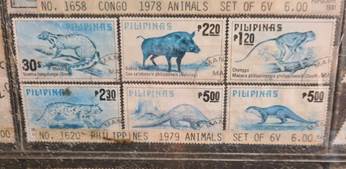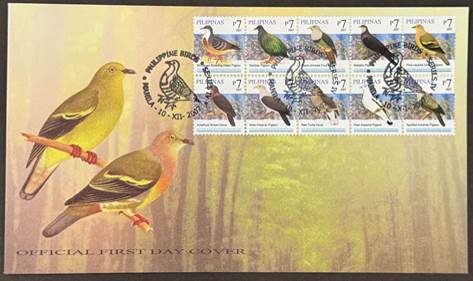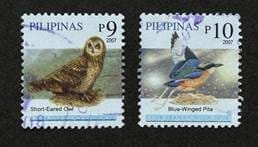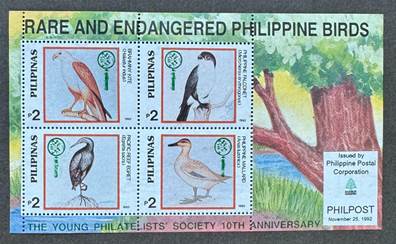By Angel Chan and Cheta Chua
Our philately story begins like this: When Angel visited Cheta in Hong Kong last August, she wanted to buy cookies at Jenny Bakery in Sheung Wan. She was approaching the pedestrian crossing near the bakery, but Cheta (as a serial jaywalker) had other plans and pulled her to cross the quiet street – she reluctantly followed.
As they reached the other side of the road, Angel (as a serial window shopper) caught sight of shiny and faded items at a storefront out of the corner of her eye. In retaliation for jaywalking, she pulled Cheta back to check these out, and unbeknown to them, it was the beginning of a new shared hobby.


Wah Hing Stamps & Coins – the beginning of our descent into the world of stamp collecting. Photos by Angel Chan.
Amongst the coins and bills from all over the world, a collection of animal stamps caught our attention behind the store’s glass. What stood out were the 1987 Philippine Parrot Stamps and 1979 Philippine Mammals Stamps, which unexpectedly showcased Philippine fauna in an unlikely setting. We quickly asked the elderly shopkeeper (who barely understood us) for a copy of the Philippine stamps, but he no longer had any for sale. Instead, he showed us various foreign animal stamps we bought for gifts and to begin our collection. Weeks later, we found ourselves in online Philippine stamp collecting groups, where we acquired copies of the stamps that had initially captivated us in the small Hong Kong shop – and more!


1984 Philippine Parrots and 1979 Philippine Mammals Stamps on Display
Photos by Angel Chan
The act of purchasing stamps online is too easy and addicting (you don’t see the total immediately!), so to be “financially responsible”, we decided to “limit” ourselves to thematic stamp collecting by completing all Philippine bird stamps and various Philippine nature stamps that we like.
We soon discovered First Day Covers or FDCs, which are envelopes with the stamp/s released on their first day and a related unique design on them.
Our rule here is to get those we find pretty as well. These limitations were not enough. As of writing, we have 6 stamp albums: (1) Philippine birds, (2) Philippine fauna and flora, (3) FDCs, (4) international birds, (5) international fauna, and (6) miscellaneous stamps, which are primarily freebies from our local sellers.

1967 Philippine Birds First Day Cover (FDC) ft. the Tuberculosis Relief Seal
The first Philippine stamps featuring PH birds were released in 1967 and featured 4 birds (PH Eagle, Rufous Hornbill, Stork-billed Kingfisher, and Great-billed Parrot). Since then, there have been many releases of different species, with the PH Eagle commonly recurring (see below). For a reason unknown to us, 2007 to 2010 stamp releases were the most comprehensive, featuring many species with the drawings directly lifted from the same plates as the Kennedy Guide.

2007 Philippine Birds FDC

Some of the various PH Eagle Stamps (1995, 1997, 2001)
Part of the appeal of bird stamp collecting is that it is interesting to observe the evolution of the art style and taxonomical changes over time. Many earlier drawings have a certain crudeness to them – possibly from the artist’s lack of reference photos and real-life bird experience.
One of the most egregious examples is the 1979 Brown-tit Babbler (see below), which looks way too different that it no longer falls under the boundaries of the license of artistic interpretation.
Even Nicaragua gave a shot at Palawan Peacock Pheasant with some horrifying results.
A lot of the birds in stamps have now been split into multiple species like the Common Flameback, which is now the Spot-throated Flameback, Asian Fairy Bluebird, which is now Palawan Fairy Bluebird, Philippine Scops Owl, which now is multiple species (Everett’s, Philippine, Palawan, and Negros).

1979 Philippine Birds Stamps

1989 Philippine Environment Month
This historical and artistic interest adds pleasure to having and preserving items from the past.
It still amazes Angel to have something older than her in good condition with the “old smell” and texture. Aside from this, Cheta is one of the most notorious listers in the entire birdwatching club.
Being able to collect these stamps gives a taste of Philippine birding despite being 1,200km away. Finding a rare stamp on a random day a seller decides to post collections for sale is like finding a lifer which fills in the hole of birdsickness. Cheta is usually the one who does the ordering, while Angel receives the package in the Philippines. Sometimes, we wait until Cheta arrives home before putting the new stamps in their collection, but Angel’s dedication to organizing often flares up, so she takes the lead and presents the additions via call.

2004 Negros Scops-owl FDC ft. WWF
As our collection grew, we noticed that the selection of species was sometimes questionable.
Many of the birds featured aren’t exactly associated with the Philippines, like the Blue-winged Pitta in 2007 (see below), which at that point had not been seen in the country for more than a century (it was eventually seen in Negros in 2018).
Other vagrants not usually associated with our country, like Mallards, Yellow-breasted bunting, Short-eared owl, and Common Shelduck, are featured.
In contrast, many of our most famous endemics like the Isabela Oriole, Flame-templed Babbler, Celestial Monarch, Short-crested Monarch, Walden’s Hornbill have never been featured. We guess it’s just a feature of the general lack of knowledge of our own endemics, while a lot of these migrants have a lot more references from abroad.

2007 Philippine Birds (December)
There is also a popular series from 1992 that features “Rare & Endangered PH Birds” but includes the very common Brahminy Kite and Pacific Reef Heron due to some other unknown reason to us. Other countries like Singapore have (just this November) featured our Negros Bleeding Heart on a stamp before we ever did (see both below).

1992 Rare & Endangered Philippine Birds

2023 SingPost Bird Paradise Commemorative Stamp: Negros Bleeding Heart
This is quite disappointing as we believe there is a lot of educational value in stamp collecting, whether it be birds, history, or other themes.
Angel, a casual birder who learns more with visuals and experience, discovers new information about nature through stamp collecting.
We have noticed that stamps are released quite frequently throughout the year, may it be a special occasion, commemoration, random occasion, etc. So there is still so much knowledge potential in this hobby in relation to our other hobby – birds!
As the birding community grows and general public knowledge improves, we want to see some of our iconic endemics beyond just the Philippine Eagle get more of the spotlight.
Philippine stamps showcase our country’s beauty locally and globally (as seen in our inception story!). Sharing these birds – whether they be used for their original purpose of mail, sealed up in folders for philatelic collection, or just flexing in social media – ingrains them in our consciousness and can create communities with shared interests. Efforts such as this to promote environmental education and conservation can play a significant role in shaping public consciousness on the importance of appreciating and preserving our Philippine endemics.
Note: All included photos of stamps and FDCs are from the Chan-Chua Stamp Collection.
